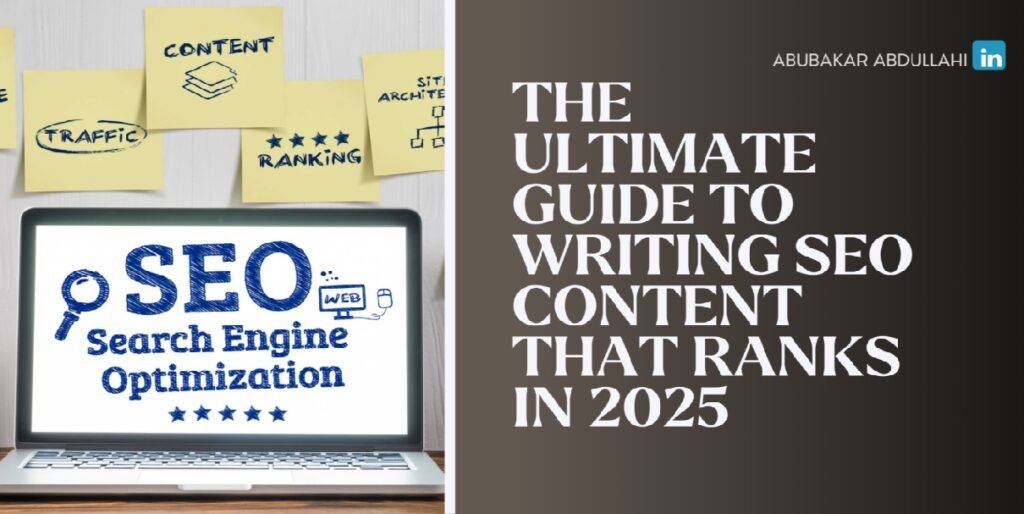
Best SEO friendly article how to wright in 2025
Creating the best SEO friendly article in 2025 means mastering new strategies for search engines. SEO content writing now requires balancing keywords with user needs. Search engines prioritize content that answers questions quickly and accurately.
This guide explains 2025 SEO techniques to improve rankings and attract audiences. It shows how to build content that ranks higher and stays relevant in today’s fast-changing digital environment. Best SEO friendly article
Key Takeaways
- Use 2025 SEO techniques to align with updated search engine rules
- Write SEO content that answers user questions directly
- Focus on readability and keyword placement for better rankings
- Balance technical SEO with engaging storytelling for results
- Create fast-loading articles to meet modern user expectations
The Evolution of SEO Content in 2025
Creating the best SEO friendly article today means keeping up with fast algorithm changes and new priorities. Search engines now look for content that adds value, not just technical tricks.
Key Changes in Search Engine Algorithms
Google’s latest updates focus on AI-driven analysis of content depth and context. Algorithms now check how well articles meet user needs through semantic understanding. For example, Best SEO friendly article Google’s 2025 Core Update favors content that fully answers questions, even if it doesn’t overuse keywords.
“Content must now be so helpful it feels like a conversation, not a keyword list.” – Google Webmaster Guidelines, 2025
Why Old SEO Tactics No Longer Work
- Keyword stuffing now triggers penalties for low-quality content
- Thin content with no original insights ranks poorly
- Manipulative backlinks harm domain authority
These obsolete SEO tactics are now harmful. Search engines mark content that focuses on rankings over readability as low-quality.
The Shift Toward User-Centric Content
Top content now focuses on user-centric content metrics like time on page and lower bounce rates. Writers need to balance E-E-A-T (Expertise, Experience, Authority, Trust) with natural language. Best SEO friendly article Putting user needs first ensures lasting visibility.
Understanding the 2025 SEO Landscape
To master the SEO landscape 2025, you need to see the big picture. Search engines now look for content that works well on many platforms and devices. They also focus on what users need.
Platforms like Baidu, Bing, and voice assistants like Alexa are big players in certain markets. Each has its own search engine priorities. Content ranking factors now value user engagement more than just keywords.
Devices play a big role too. Smart speakers, wearables, and mobile-first designs change how we use content. Content ranking factors now include how well content works on all devices, from tablets to AR interfaces. Best SEO friendly article
Social media platforms like TikTok and Pinterest are also important. They mix discovery with sharing. This means visual content like videos and infographics are key for shares and backlinks.
- Vertical search engines focus on specific areas: Travel blogs need to optimize for flight tools; recipe sites for cooking timers.
- AI tools like Google’s Gemini and Microsoft’s Qwen look at context. This makes clear and accurate content important for rankings.
- Interactive content like quizzes or 3D demos do better than static pages in best SEO friendly article strategies.
The SEO landscape 2025 values content that’s both optimized and human-focused. It’s about meeting user needs, not just technical tricks. The next sections will show how to create content that excels in this new world.
Essential Elements of a Best SEO Friendly Article
To make a best SEO friendly article in 2025, focus on four key areas. These are content quality, technical optimization, user experience, and E-E-A-T principles. Each part is crucial for better rankings and happy readers.
Content Quality Factors
First, focus on content quality. Look for deep research, original ideas, and facts. Stay away from generic content. Users and search engines like content that solves problems.
For instance, health blogs should reference medical studies. Tech guides should break down complex topics clearly.
Technical SEO Aspects
Technical SEO makes sure your content is easy to find and loads quickly. Use schema markup to highlight important information. For example, product prices or event dates.
Optimize images with clear filenames and alt text. Try to make pages load in under 3 seconds. Google PageSpeed Insights can help with this.
User Experience Considerations
Users want a smooth experience. Use short paragraphs and easy-to-read headings. Add interactive features like collapsible FAQs.
Content length should match the topic’s depth. Short answers for quick questions, detailed guides for deeper topics. Make sure mobile layouts are easy to use with touch-friendly buttons and clear fonts.
E-E-A-T in 2025
E-E-A-T (E-E-A-T principles) now means showing real proof of your expertise. Share credentials (like “According to NASA,…”). Include author bios with professional affiliations and link to trusted sources.
Avoid making vague claims. Always support your statements with solid evidence.
“Content must earn trust through expertise and transparency.” – Google Core Web Vitals Guidelines
AI and Machine Learning in SEO Writing
AI tools like Grammarly and Copyleaks are changing how we write content. But, the best SEO articles still Best SEO friendly article need a human touch. Machines are great at analyzing data and finding keywords. Yet, creativity and understanding come from people. Here’s how to mix technology with human talent.
“AI is a paintbrush, not the artist.” — SEO pioneer Rand Fishkin
Balancing AI Tools with Human Creativity
AI tools make writing and editing easier, but don’t rely on them too much. Use them for:
- Keyword clustering with tools like SEMrush
- Grammar checks and plagiarism scans
- Content gap analysis with Surfer SEO
Humans should focus on storytelling, emotions, and making ethical choices. Let AI do the hard work, but keep the content’s heart alive.
Voice Search Optimization Techniques
Voice search needs a conversational tone. Write as if you’re talking:
- Use question phrasing (“How to bake gluten-free bread?”)
- Include location-based keywords naturally
- Focus on concise, answer-focused sentences
Optimize for featured snippets to lead in voice search results.
Semantic SEO Foundations
Semantic SEO focuses on context over keywords. Create content around main topics using:
- Entity linking (e.g., linking “Tesla” to “electric cars” and “Elon Musk”)
- Topic clusters for related keywords
- Natural keyword variations
Tools like Ahrefs help find semantic connections without forcing keyword density.
Keyword Strategy for Maximum Visibility
Creating the best SEO friendly article begins with a solid keyword strategy. Today’s keyword research goes beyond just listing terms. It’s about understanding how users search. Tools like SEMrush or Ahrefs show where competitors are missing and connect related terms.
Search intent matching is key. Think about what the user is looking for. A recipe search wants step-by-step guides, while a “how-to” guide needs visuals. Make sure your content matches these needs to rank better. Being an authority in your topic also helps, as it builds trust with search engines.
When it comes to keyword implementation, aim for natural placement. Put main terms in headers and the beginning of paragraphs. But let secondary terms flow naturally. Remember, Google frowns upon keyword stuffing. Here’s how to get it right:
- Use headers (H2, H3) to group related keywords thematically.
- Write for readers first; sprinkle keywords where they fit conversations.
- Check tools like Yoast to flag over-optimized phrases.
In 2025, keyword strategy is about depth, not just density. Focus on solving user problems and weaving keywords into a cohesive, authoritative story.
Content Structure and Formatting Best Practices
To make the best SEO friendly article in 2025, focus on content formatting. It should meet user needs and search engine standards. A well-structured article ranks better and keeps readers interested. Here’s how to improve each part:
Header Optimization Techniques
Headers help readers and search engines understand your content. Use header optimization to:
- Put primary keywords in H2 and H3 tags naturally.
- Organize headers clearly (H2 for main topics, H3 for details).
- Make headers into questions or phrases people might search for.
Paragraph Structure for Better Engagement
Short paragraphs make your content easier to read. Aim for:
- 2-3 sentences per paragraph.
- Start with a sentence that sums up the section’s main point.
- Use space between sections to avoid a messy look.
Strategic Use of Lists and Tables
Use lists and tables to simplify complex information. Try:
- Bulleted lists for important points or step-by-step guides.
- Tables to compare items, data, or features.
- Numbered lists for steps or rankings.
Mobile-First Content Design
Make your content mobile-friendly by:
- Choosing responsive layouts that adjust to any screen size.
- Ensuring buttons and interactive parts are easy to use on touch screens.
- Putting important information above the fold on mobile screens.
Google favors content that’s easy to read on phones. Check how your site works on different devices. Make sure it loads quickly and is easy to navigate.
Multimedia Elements That Boost SEO Performance
Today, SEO focuses on rich media to grab attention and climb the ranks. The best SEO friendly article in 2025 combines images, videos, and interactive tools. This makes the content more engaging. Search engines like Google give high marks to content that looks good and works well.
- Image optimization: Use WebP formats for smaller file sizes, compress JPEGs to under 100KB, and write descriptive alt text. Tools like TinyPNG simplify this process.
- Video SEO: Embed videos via YouTube or Vimeo, add closed captions, and include transcripts. Schema markup helps search engines index video content accurately.
- Infographics: Optimize with concise text overlays and share buttons. Platforms like Canva make creating SEO-ready visuals easy.
- Interactive content: Embed quizzes, maps, or calculators to boost dwell time. Tools like Typeform or Hotjar track user engagement effectively.
“Multimedia isn’t just supplementary—it’s core to how users digest information today,” says Sarah Johnson, a 2025 SEO analyst at Moz. “Prioritizing image optimization and video SEO ensures content stays relevant and discoverable.”
To get the best SEO friendly article results, mix multimedia with clear headings and keyword-rich captions. Make sure it works well on mobile devices. Use Google’s PageSpeed Insights to check loading speeds. By combining visuals and interactive elements, creators meet 2025’s user-focused search trends while keeping technical standards high.
Writing for Search Intent: The 2025 Approach
Aligning with search intent is key for the best SEO friendly article. Today’s algorithms look for content that really meets user needs. Here’s how to make content for three main intent types:
Informational Content Strategies
Create informational content that answers detailed questions well. Use structured guides like:
- Step-by-step tutorials with expert sources cited
- FAQ sections addressing related subtopics
- Comparisons of industry trends or tools
For example, a “How to Choose Solar Panels” article should include cost breakdowns, installation guides, and regional incentives.
Commercial Intent Optimization
For commercial content, aim to help with decision-making without pushing too hard. Key tactics include:
- Product comparison tables (e.g., “Apple vs. Samsung Smartphones 2025”)
- Customer testimonials with trust badges (e.g., “50,000+ Amazon reviews verified”)
- Interactive tools like price calculators or warranty checkers
Navigational Search Considerations
Optimize for navigational search by:
- Using exact brand terms: “Nike Air Max 2025 sizing guide”
- Geo-targeted content for local businesses
- Clear internal linking to product pages
Brands like Best Buy use location tags like “Chicago electronics repair” to catch local navigational search queries.
Link Building Through Quality Content
In 2025, the best SEO strategies focus on creating content that naturally attracts links. This content is so valuable that others want to reference, cite, or share it. Here’s how to make your content link-worthy.
Creating Naturally Linkable Assets
Linkable content is special because it solves problems or offers unique value. Look into these formats:
- Original research: Publish data-driven studies (e.g., HubSpot’s annual content marketing reports)
- Interactive tools: Build SEO calculators or comparison charts (like Moz’s Keyword Explorer)
- Definitive guides: Write comprehensive how-tos that dominate search results (similar to Google’s Webmaster Guidelines)
Internal Linking Strategies
Internal linking boosts site authority by connecting related topics. Use these strategies:
- Link older posts to new updates on the same topic
- Use keyword-rich anchor text like “SEO tools for 2025” instead of “click here”
- Create topic clusters around core themes (e.g., linking all social media guides to a central “social SEO” pillar page)
The Role of Citations and References
“Citations build trust when they’re relevant and properly attributed.” — Google’s E-E-A-T guidelines
Include content citations from authoritative sources to add credibility. For example, citing Pew Research data in an article about social media trends. Reaching out to cited experts can spark collaborations or reciprocal links.
Focus on creating content so useful it becomes a go-to reference. This approach aligns with 2025’s search algorithms, which favor helpful, shareable material.
Measuring the Success of Your SEO Content
Measuring your best SEO friendly article success is more than just page views. Today’s content performance metrics should show how well your content meets user needs and business goals. Start by setting key indicators like time on page, bounce rates, and conversion triggers tied to your content’s purpose.
- Track engagement: Use heatmaps and scroll tracking to see where readers focus.
- Monitor rankings: Tools like SEMrush and Ahrefs show keyword progress.
- Calculate conversions: Tie content to sales, signups, or downloads to measure content ROI.
Advanced SEO analytics platforms like Google Analytics 4 let you segment data by device, audience, and content type. For example, a blog post about “sustainable gardening” might show higher engagement on mobile devices. This guides future content formats. Best SEO friendly article
“Data without action is just a story. Use analytics to refine your strategy, not just report progress.” – SEMrush 2025 SEO Trends Report
Calculating content ROI means linking content to revenue. Suppose a how-to guide drives 10% more email signups. Multiply that by the average customer value to quantify its worth. Tools like Hotjar and Google’s Core Web Vitals also highlight technical improvements affecting rankings.
Regular audits compare content performance over quarters. If an article’s search traffic drops, check algorithm updates or competitor activity. Adjusting based on these insights ensures your content stays relevant and profitable in 2025 and beyond. Best SEO friendly article
Conclusion: Creating Sustainable SEO Content Strategies for 2025 and Beyond
To build a lasting SEO strategy for 2025, start with the best practices for SEO-friendly articles. First, focus on what users need. Then, optimize technical aspects like page speed and mobile design. Content that lasts combines timeless topics with current trends.
SEO content planning must be flexible. Set aside time for both in-depth guides and quick updates on new trends. Use tools like Google Analytics to see how well your content does and make changes as needed. Choose topics and sources that show expertise, experience, and trust.
Plan your content with a mix of new and updated articles. Begin with small steps: update one old post each week or publish a how-to guide every month. Even small efforts can build your authority over time. Remember, sustainable strategies focus on clarity, value, and easy reading for lasting rankings.
Content that excels in 2025 will be well-planned. Use keyword-rich headlines but also write naturally. Always consider what users want, from product reviews to how-to guides. With consistent effort and flexibility, your content will attract both search engines and real people.
FAQ
What are the main SEO changes to expect in 2025?
In 2025, SEO will focus more on user experience and AI. Content will need to meet user intent. Best SEO friendly article Search engines will look for engaging, high-quality content that adds value.
How can I improve the quality of my SEO content?
To improve your SEO content, focus on original, in-depth information. Make sure it meets your audience’s needs. Use diverse content formats like images and videos. Keep your writing organized for easy reading.
Why is user intent so important for SEO?
Understanding user intent is key because it helps you create relevant content. By addressing specific needs, you can boost your visibility and engagement in search results. Best SEO friendly article
What role does AI play in SEO writing for 2025?
AI tools can help with content generation and optimization. But, it’s important to balance AI with human creativity. AI can streamline processes, but human insights are crucial for engaging content. Best SEO friendly article
How can I create SEO-friendly multimedia content?
To boost SEO with multimedia content, optimize images and videos. Use proper file formats and alt text for images. Include transcripts for videos. Infographics can help explain complex topics. Make sure multimedia complements your written content.
What are linkable assets and how can I create them?
Linkable assets are high-quality content that attracts backlinks. Examples include original research, comprehensive guides, Best SEO friendly article or unique tools. Create valuable, in-depth resources that offer meaningful insights and solutions.
How should I measure the success of my SEO content?
Measure success with key performance indicators like organic traffic and engagement metrics. Use analytics tools to track performance. Analyze data to refine your SEO strategy.






